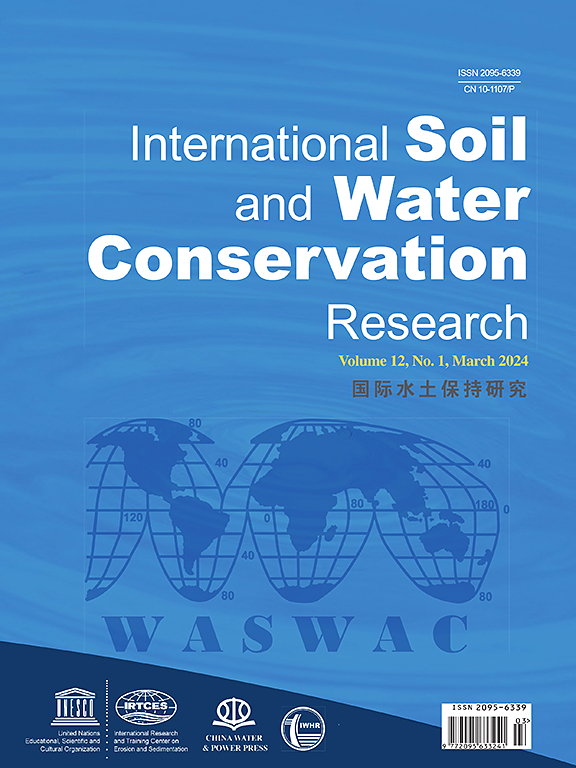对三江源地区历史和未来时期的水文气候要素进行综合分析:向强化的水文循环转变
IF 7.3
1区 农林科学
Q1 ENVIRONMENTAL SCIENCES
International Soil and Water Conservation Research
Pub Date : 2024-01-26
DOI:10.1016/j.iswcr.2024.01.005
引用次数: 0
摘要
三江源区(TRSR)是中国的水塔,也是中国重要的生态屏障,为下游地区提供了相当多的水,超过5亿人口。重点评估历史和未来时期降水、实际蒸散发、潜在蒸散发、地表流量、基流、河川流量、土壤湿度、融雪水、陆地储水量等水文要素及其随最高气温、最低气温、平均气温、相对湿度、风速、日照时数等气象要素的变化趋势。为此,应用水文模型HEC-HMS模拟水文成分和Mann-Kendal,探讨1981-2015年的趋势。首次利用统计降尺度模型SDSM生成区域共享社会经济情景-5 (SSP585)下的气候数据,并将其应用于水文循环模拟。评价结果表明,降水转化为蒸散发和径流的比例分别为70%和30%。在该地区,78%、22%和5.6%的流量由基流、地表流和融雪产生。趋势结果表明,除蒸散发外,所有气候变量在历史时期内均呈现显著趋势,但在水文分量上均不显著。然而,除风速外,所有水文气候分量在未来都预计会增加。例如,与1981-2020年相比,2021-2060年(2061-2100年)气温、降水、蒸散发、河流流量和直接流量(地表流量)将分别增加1.4(3.3)°C、12(36)%、8.5(19)%、25(95)%和77(473)%,表明该地区未来将变得更热、更湿,具有较高的洪水潜力。这些结果将有助于在这个气候变化极其敏感的地区进行精确的水资源规划和管理。本文章由计算机程序翻译,如有差异,请以英文原文为准。

An integrative analysis of hydroclimatic elements in the three-river source region for historical and future periods: Shift toward an intensified hydrological cycle
The Three-River Source Region (TRSR), China's water tower and an important ecological barrier in China, provides a considerable amount of water to the downstream regions, home to more than 500 million people. The present study focused on the assessment of hydrological components (i.e., precipitation, actual evapotranspiration, potential evapotranspiration, surface flow, baseflow, streamflow, soil moisture, snowmelt water, and terrestrial water storage), their transformation and trends along with meteorological elements (i.e., maximum temperature, minimum temperature, mean temperature, relative humidity, wind speed, and sunshine hours) in the historical and future periods. For this, the hydrological model, HEC-HMS, was applied to simulate hydrological components and Mann-Kendal to explore the trends for 1981–2015. First time, the statistical downscaling model, SDSM, was used to generate climatic data under the shared socio-economic scenario-5 (SSP585) in the region, which was applied to simulate the hydrological cycle. The assessment results showed that precipitation transformed into evapotranspiration and streamflow by 70 % and 30 %, respectively. In the region, streamflow was generated by 78 %, 22 %, and 5.6 % by baseflow, surface flow, and snowmelt. According to trend results, all climatic variables showed statistically significant trends but insignificant in all hydrological components for the historical period, except evapotranspiration. However, all hydroclimatic components were projected to increase in the future, except windspeed. For example, temperature, precipitation, evapotranspiration, streamflow, and direct flow (surface flow) will increase by 1.4 (3.3) °C, 12 (36) %, 8.5 (19) %, 25 (95) %, and 77 (473) % in 2021–2060 (2061–2100) relative to 1981–2020, which shows, the region will be hotter and wetter, with high flooding potential in the future. These results will be helpful for precise water resources planning and management in this extremely sensitive region to climate change.
求助全文
通过发布文献求助,成功后即可免费获取论文全文。
去求助
来源期刊

International Soil and Water Conservation Research
Agricultural and Biological Sciences-Agronomy and Crop Science
CiteScore
12.00
自引率
3.10%
发文量
171
审稿时长
49 days
期刊介绍:
The International Soil and Water Conservation Research (ISWCR), the official journal of World Association of Soil and Water Conservation (WASWAC) http://www.waswac.org, is a multidisciplinary journal of soil and water conservation research, practice, policy, and perspectives. It aims to disseminate new knowledge and promote the practice of soil and water conservation.
The scope of International Soil and Water Conservation Research includes research, strategies, and technologies for prediction, prevention, and protection of soil and water resources. It deals with identification, characterization, and modeling; dynamic monitoring and evaluation; assessment and management of conservation practice and creation and implementation of quality standards.
Examples of appropriate topical areas include (but are not limited to):
• Conservation models, tools, and technologies
• Conservation agricultural
• Soil health resources, indicators, assessment, and management
• Land degradation
• Sustainable development
• Soil erosion and its control
• Soil erosion processes
• Water resources assessment and management
• Watershed management
• Soil erosion models
• Literature review on topics related soil and water conservation research
 求助内容:
求助内容: 应助结果提醒方式:
应助结果提醒方式:


